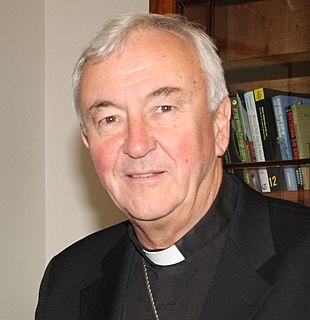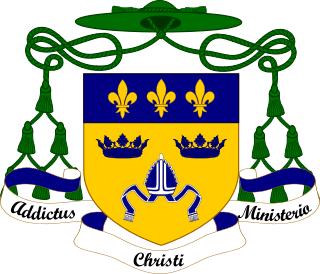
The Archbishop of Canterbury is the senior bishop and principal leader of the Church of England, the symbolic head of the worldwide Anglican Communion and the diocesan bishop of the Diocese of Canterbury. The current archbishop is Justin Welby, who was enthroned at Canterbury Cathedral on 21 March 2013. Welby is the 105th in a line which goes back more than 1400 years to Augustine of Canterbury, the "Apostle to the English", sent from Rome in the year 597. Welby succeeded Rowan Williams.

Pope John Paul II was the head of the Catholic Church and sovereign of the Vatican City State from 1978 until his death in 2005. He was elected pope by the second papal conclave of 1978, which was called after John Paul I, who had been elected in August to succeed Pope Paul VI, died after 33 days. Cardinal Wojtyła was elected on the third day of the conclave and adopted the name of his predecessor in tribute to him. John Paul II is recognised as helping to end Communist rule in his native Poland and the rest of Europe.

Óscar Arnulfo Romero y Galdámez was a prelate of the Catholic Church in El Salvador. He served as auxiliary bishop of the archdiocese of San Salvador, as bishop of Santiago de María, and finally as the fourth archbishop of San Salvador. As archbishop, Romero spoke out against social injustice and violence amid the escalating conflict between the military government and left-wing insurgents that led to the Salvadoran Civil War. In 1980, Romero was shot by an assassin while celebrating mass. Though no one was ever convicted for the crime, investigations by the UN-created Truth Commission for El Salvador concluded that Major Roberto D'Aubuisson, founder of the right-wing ARENA political party, had ordered the killing.

Robert Alexander Kennedy Runcie, Baron Runcie, was an English Anglican bishop. He was the Archbishop of Canterbury from 1980 to 1991, having previously been Bishop of St Albans. He travelled the world widely to spread ecumenicism and worked to foster relations with both Protestant and Catholic churches across Europe. He was a leader of the Liberal Anglo-Catholicism movement. He came under attack for expressing compassion towards bereaved Argentines after the Falklands War of 1982, and generated controversy by supporting women's ordination.

Cormac Murphy-O'Connor was a British cardinal of the Roman Catholic Church, Archbishop of Westminster and president of the Catholic Bishops' Conference of England and Wales. He was made cardinal by Pope John Paul II in 2001. He submitted his resignation as archbishop on reaching his 75th birthday in 2007; Pope Benedict XVI accepted it on 3 April 2009.
Maurice Noël Léon Couve de Murville was a French-born British Roman Catholic bishop. He was the seventh Archbishop of Birmingham from 25 March 1982 until his retirement on 12 June 1999, having formerly been a priest of the Diocese of Arundel and Brighton and chaplain of Fisher House, Cambridge.

Coventry Airport is located 3 NM south-southeast of Coventry city centre, in the village of Baginton, Warwickshire, England. The airport is operated by Coventry Airport Limited, and has a CAA Ordinary Licence that allows flights for the public transport of passengers or for flying instruction as authorised by the licensee, Coventry Airport Limited.

Vincent Gerard Nichols is an English cardinal of the Roman Catholic Church, Archbishop of Westminster and President of the Catholic Bishops' Conference of England and Wales. He previously served as Archbishop of Birmingham from 2000 to 2009. On 22 February 2014, Pope Francis admitted Archbishop Nichols to the Sacred College of Cardinals at a general consistory.

The Roman Catholic Diocese of East Anglia is a diocese of the Latin Church of the Roman Catholic Church covering the counties of Cambridgeshire, Norfolk, Suffolk, and Peterborough in eastern England. The diocese makes up part of the Catholic Association Pilgrimage.
Faustino Sainz Muñoz was a Spanish prelate of the Roman Catholic Church. He served as the Nuncio to Great Britain from 2004 until December 2010, having been appointed by Pope John Paul II in 2004.

Holy See–United Kingdom relations are foreign relations between the Holy See and the United Kingdom.

Bernard Longley is an English prelate of the Roman Catholic Church. He was named the Archbishop of Birmingham on 1 October 2009, and installed by Bishop David McGough and presented with his crozier by Archbishop Vincent Nichols, his predecessor, in St Chad's Cathedral at a Solemn Mass on 8 December 2009, the Feast of the Immaculate Conception, attended by 600 people. Previously he was an Auxiliary Bishop of Westminster.

John Henry Newman was a Roman Catholic theologian, philosopher and cardinal who converted to Roman Catholicism from Anglicanism in October 1845. In early life, he was a major figure in the Oxford Movement to bring the Church of England back to its roots. Eventually his studies in history persuaded him to become a Roman Catholic priest, and he has now become a Saint, having been canonised on 13 October 2019. In 1991, Newman was proclaimed "Venerable" by the Congregation for the Causes of Saints – the first stage in the canonisation process. He was beatified on 19 September 2010 at an open air mass in Birmingham.

The state visit of Pope Benedict XVI to the United Kingdom was held from 16 to 19 September 2010 and was the first visit by a Pope to Britain after Pope John Paul II made a pastoral, rather than state, visit in 1982. The visit included the beatification of Cardinal Newman as a "pastoral highlight".

The Catholic Church in North America refers to the Catholic Church in North America, in full communion with the Holy See in Rome, including its various geographical coverage on the continent. It is prevalent in many different countries, on the mainland and in both island countries and overseas territories, such as the United States, the Dominican Republic, and El Salvador.

Pope John Paul II visited Ireland from Saturday, 29 September to Monday, 1 October 1979, the first trip to Ireland by a pope. Over 2.5 million people attended events in Dublin, Drogheda, Clonmacnoise, Galway, Knock, Limerick, and Maynooth. It was one of John Paul's first foreign visits as Pope, who had been elected in October 1978. The visit marked the centenary of the reputed apparitions at the Shrine of Knock in August 1879.

Pope Francis made a pastoral and state visit to the Philippines from January 15 to 19, 2015. He was the third pontiff to visit the Philippines and the first in the 21st century, after Paul VI in 1970 and John Paul II in 1995. Besides Manila, Francis visited Tacloban and Palo, Leyte, to encourage the victims of Typhoon Haiyan (Yolanda). The Filipinos nicknamed Francis Lolo Kiko as a term of endearment, which he commended. Around 6–7 million attended Francis' final Mass at Luneta, surpassing the crowd at World Youth Day 1995 in the same venue and making it the largest papal crowd in history. The theme of Francis' 2015 visit was "Mercy and Compassion".

















